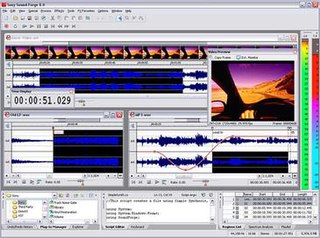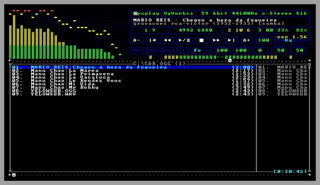Related Research Articles
An audio file format is a file format for storing digital audio data on a computer system. The bit layout of the audio data is called the audio coding format and can be uncompressed, or compressed to reduce the file size, often using lossy compression. The data can be a raw bitstream in an audio coding format, but it is usually embedded in a container format or an audio data format with defined storage layer.

Microsoft DirectX is a collection of application programming interfaces (APIs) for handling tasks related to multimedia, especially game programming and video, on Microsoft platforms. Originally, the names of these APIs all began with Direct, such as Direct3D, DirectDraw, DirectMusic, DirectPlay, DirectSound, and so forth. The name DirectX was coined as a shorthand term for all of these APIs and soon became the name of the collection. When Microsoft later set out to develop a gaming console, the X was used as the basis of the name Xbox to indicate that the console was based on DirectX technology. The X initial has been carried forward in the naming of APIs designed for the Xbox such as XInput and the Cross-platform Audio Creation Tool (XACT), while the DirectX pattern has been continued for Windows APIs such as Direct2D and DirectWrite.
Waveform Audio File Format is an audio file format standard, developed by Microsoft and IBM, for storing an audio bitstream on PCs. It is an application of the Resource Interchange File Format (RIFF) bitstream format method for storing data in "chunks", and thus is also close to the 8SVX and the AIFF format used on Amiga and Macintosh computers, respectively. It is the main format used on Microsoft Windows systems for raw and typically uncompressed audio. The usual bitstream encoding is the linear pulse-code modulation (LPCM) format.
The Resource Interchange File Format (RIFF) is a generic file container format for storing data in tagged chunks. It is primarily used to store multimedia such as sound and video, though it may also be used to store any arbitrary data.

Renoise is a digital audio workstation (DAW) based upon the heritage and development of tracker software. Its primary use is the composition of music using sound samples, soft synths, and effects plug-ins. It is also able to interface with MIDI and OSC equipment. The main difference between Renoise and other music software is the characteristic vertical timeline sequencer used by tracking software.
DirectPlay is part of Microsoft's DirectX API. It is a network communication library intended for computer game development, although it can be used for other purposes.

Microsoft XNA is a freeware set of tools with a managed runtime environment provided by Microsoft that facilitates video game development and management. XNA is based on the .NET Framework, with versions that run on Windows NT, Windows Phone and the Xbox 360. XNA content is built with the XNA Game Studio, and played using the XNA Framework, or published as native executables.
DirectMusic is a deprecated component of the Microsoft DirectX API that allows music and sound effects to be composed and played and provides flexible interactive control over the way they are played. Architecturally, DirectMusic is a high-level set of objects, built on top of DirectSound, that allow the programmer to play sound and music without needing to get quite as low-level as DirectSound. DirectSound allows for the capture and playback of digital sound samples, whereas DirectMusic works with message-based musical data. Music can be synthesized either in hardware, in the Microsoft GS Wavetable SW Synth, or in a custom synthesizer.
Game programming, a subset of game development, is the software development of video games. Game programming requires substantial skill in software engineering and computer programming in a given language, as well as specialization in one or more of the following areas: simulation, computer graphics, artificial intelligence, physics, audio programming, and input. For massively multiplayer online games (MMOGs), knowledge of additional areas such as network programming and database programming are required. Though often engaged in by professional game programmers, some may program games as a hobby.
The Xbox Development Kit (XDK) is a software development kit created by Microsoft used to write software for the Xbox gaming system. The XDK includes libraries, a compiler, and various tools used to create software for the Xbox. The XDK has the option to integrate itself into Microsoft Visual Studio 2002 or 2003. This is needed if one wants to develop applications or games for the Xbox. The XDK also includes a tool to record in-game footage, which has been widely used to create high-quality screenshots and trailers.

Sound Forge is a digital audio editing suite by Magix Software GmbH, which is aimed at the professional and semi-professional markets. There are two versions of Sound Forge: Sound Forge Pro 12 released in April 2018 and Sound Forge Audio Studio 13 released in January 2019. Both are well known digital audio editors and offer recording, audio editing, audio mastering and processing audio.
This article describes audio APIs and components in Microsoft Windows which are now obsolete or deprecated.
FMOD is a proprietary sound effects engine and authoring tool for video games and applications developed by Firelight Technologies, that play and mix sounds of diverse formats on many operating systems.

WaveLab is a digital audio editor and recording computer software application for Windows and macOS, created by Steinberg. WaveLab was started in 1995 and it is mainly the work of one programmer, Philippe Goutier.

Mpxplay is a 32-bit console audio player for MS-DOS and Windows. It supports a wide range of audio codecs, playlists, as well as containers for video formats. The MS-DOS version uses a 32-bit DOS extender.
ShiVa3D is a 3D game engine with a graphical editor designed to create applications and video games for desktop PCs, the web, game consoles and mobile devices. Games made with ShiVa can be exported to over 20 target platforms, with new export targets being added regularly.

Microsoft XNA Game Studio is an integrated development environment (IDE) for building video games on the Microsoft XNA platform. Such video games can run on Xbox 360, Microsoft Windows, Windows Phone and the Zune. XNA Game Studio is targeted at hobbyists and experienced programmers, and is primarily used to develop 2D and 3D video games for various Microsoft platforms. XNA games can be published for the Xbox 360 using an XNA Creator's Club membership, that has a yearly fee.
A sound card mixer is the analog part of a sound card that routes and mixes sound signals. This circuit receives inputs from both external connectors and the sound card's digital-to-analog converters. It selects or mutes, amplifies these signals, adds them together, and finally routes the result to both external output connectors and the sound card's analog-to-digital converters. Different mixing schemes are in use, but the ones implemented in most IBM-PC compatible computers today are variants of a scheme defined in Intel's AC'97 Audio Component Specification.
XAudio2 is a lower-level audio API for Microsoft Windows, Xbox 360 and Windows Phone 8, the successor to DirectSound on Windows and a supplement to the original XAudio on the Xbox 360.